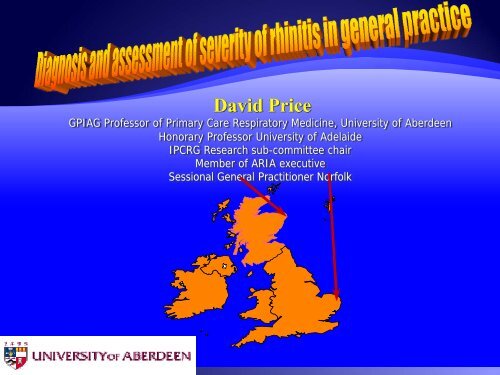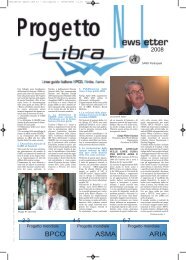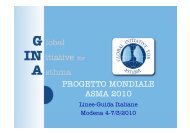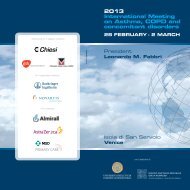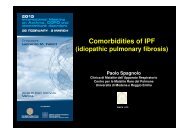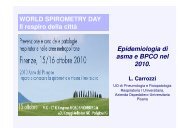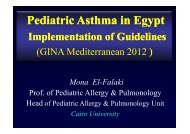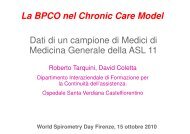David Price - Progetto LIBRA
David Price - Progetto LIBRA
David Price - Progetto LIBRA
You also want an ePaper? Increase the reach of your titles
YUMPU automatically turns print PDFs into web optimized ePapers that Google loves.
<strong>David</strong> <strong>Price</strong><br />
GPIAG Professor of Primary Care Respiratory Medicine, University of Aberdeen<br />
Honorary Professor University of Adelaide<br />
IPCRG Research sub-committee chair<br />
Member of ARIA executive<br />
Sessional General Practitioner Norfolk
Selling haggis<br />
Catching fish<br />
Making kilts<br />
Making whisky
Aberdeen because of the “Silver Darling”
UK BTS 1997 –word rhinitis<br />
not mentioned<br />
BTS 2003:<br />
assisting in making a diagnosis<br />
of asthma<br />
immunotherapy for rhinitis<br />
sufferers might reduce rate of<br />
onset of asthma<br />
many patients with asthma<br />
may have rhinitis<br />
but no evidence that its<br />
treatment improves asthma<br />
outcomes<br />
GINA 2002<br />
treatment of rhinitis may<br />
improve asthma outcomes
Rhinitis<br />
Allergic<br />
• Intermittent<br />
• Persistent<br />
Infectious<br />
• Acute<br />
• Chronic<br />
Other<br />
eg:<br />
• Idiopathic<br />
• Hormonal<br />
• Drug-induced<br />
• Differential diagnosis<br />
– Polyps – Malignancy<br />
– Septum – Bacterial/viral infections
Allergic 1,2* Non-Allergic 1<br />
Pollen<br />
House dust mite<br />
Animal dander<br />
Moulds<br />
Grasses<br />
Occupational<br />
allergens<br />
Infection eg: virus<br />
Chemical irritants<br />
Hormonal<br />
Drug-induced<br />
Emotional<br />
Idiopathic<br />
*<br />
Allergic rhinitis symptoms may be further exacerbated by airborne pollutants 3,4<br />
1. International Rhinitis Management Working Group. Allergy 1994; 49 (Suppl 19): 1-34.<br />
2. Dykewicz et al. Ann Allergy Asthma Immunol 1998; 81: 478-518.<br />
3. DoH Advisory Group on the Aspects of Air Pollution Episodes. London: HMSO 1995.<br />
4. Ormstad et al. Clin Exp Allergy 1998; 28: 702-708.
Gendo, K. et. al. Ann Intern Med 2004;140:278-289
Gendo, K. et. al. Ann Intern Med 2004;140:278-289
If disease persistent or not responding as should<br />
allergy testing is essential before considering<br />
immunotherapy<br />
SPTs and IgE testing little differential in terms of<br />
likelihood of success
Asthma<br />
(range 1.6–36.8%)<br />
8.0%<br />
Allergic<br />
rhinitis<br />
(range 1.4–39.7%)<br />
3.4%<br />
1.2%<br />
1.3%<br />
7.5%<br />
1.3% 3.6%<br />
Atopic dermatitis<br />
(range 0.3–20.5%)<br />
n=463,801 aged 13–14 years<br />
ISAAC. Lancet 1998
ARIA Classification<br />
Intermittent<br />
. ≤ 4 days per week<br />
. or ≤ 4 weeks<br />
Persistent<br />
. > 4 days per week<br />
. and > 4 weeks<br />
Mild<br />
normal sleep<br />
& no impairment of daily<br />
activities, sport, leisure<br />
& normal work and school<br />
& no troublesome symptoms<br />
Moderate‐severe<br />
one or more items<br />
. abnormal sleep<br />
. impairment of daily activities,<br />
sport, leisure<br />
. abnormal work and school<br />
. troublesome symptoms<br />
in untreated patients
IPCRG rhinitis guidelines based on ARIA:<br />
Unimpaired sleep<br />
Ability to undertake normal daily activities, including<br />
work and school attendance, without limitation or<br />
impairment, and the ability to participate fully in<br />
sport and leisure activities<br />
No troublesome symptoms<br />
No or minimal side‐effects of rhinitis treatment<br />
<strong>Price</strong> D, Bond C, Bouchard J, Costa R, Keenan J, Levy M, Orru M, Ryan D, Walker S, Watson M. International Primary Care<br />
Respiratory Group (IPCRG) Guidelines: Management of allergic rhinitis. Primary Care Respiratory Journal. 2006;15:58-70
Assessment: Royal College of<br />
Physicians of London three questions<br />
IN THE LAST WEEK / MONTH<br />
“Have you had difficulty sleeping because of your asthma<br />
symptoms (including cough)?”<br />
“Have you had your usual asthma symptoms during the day<br />
(cough, wheeze, chest tightness or breathlessness)?”<br />
“Has your asthma interfered with your usual activities<br />
(e.g. housework, work, school, etc)?”<br />
Date / / /<br />
YES<br />
NO<br />
Page 20<br />
© Imperial College London<br />
Outcomes and audit. Thorax 2003; 58 (Suppl I): i1-i92
Asthma Control Test (ACT)<br />
1. In the past 4 weeks, how much of the time did your asthma keep you from<br />
getting as much done at work, school or at home?<br />
Score<br />
2. During the past 4 weeks, how often have you had shortness<br />
of breath?<br />
3. During the past 4 weeks, how often did your asthma symptoms<br />
(wheezing, coughing, shortness of breath, chest tightness or pain)<br />
wake you up at night, or earlier than usual in the morning?<br />
4. During the past 4 weeks, how often have you used your rescue<br />
inhaler or nebulizer medication (such as salbutamol)?<br />
5. How would you rate your asthma control during the past<br />
4 weeks?<br />
Copyright 2002, QualityMetric Incorporated.<br />
Asthma Control Test Is a Trademark of QualityMetric Incorporated.<br />
Patient Total Score
Sneezing<br />
72%<br />
Runny nose<br />
66%<br />
Intermittent allergic<br />
rhinitis only<br />
71%<br />
Blocked nose<br />
59%<br />
Itchy nose<br />
58%<br />
Persistent allergic<br />
rhinitis only<br />
25%<br />
Itchy/ red eyes<br />
Watery eyes<br />
39%<br />
45%<br />
Post nasal drip<br />
33%<br />
Both IAR and PAR<br />
5%<br />
Itchy palate<br />
29%<br />
Cough<br />
26%<br />
Headache<br />
23%<br />
Snoring as a result of symptoms<br />
22%<br />
Sinus pressure<br />
21%<br />
Waking up in the night as a result of<br />
symptoms<br />
19%<br />
Sore throat<br />
17%<br />
Wheezing<br />
15%<br />
0% 40% 80%
Impact of symptoms<br />
Q11. For each of the symptoms you’ve mentioned, please rank them in order of the<br />
degree of impact they have on your ability to perform your daily tasks<br />
Symptom<br />
Frequency<br />
% PCPs ranking this<br />
symptom in the TOP third*<br />
% PCPs ranking this<br />
symptom in the BOTTOM<br />
third*<br />
Runny nose 66% 32% 19%<br />
Increasing impact of symptoms<br />
Blocked nose 59% 33% 14%<br />
Itchy / red eyes 45% 22% 14%<br />
Sneezing 72% 27% 26%<br />
Watery eyes 39% 16% 13%<br />
Cough 26% 13% 8%<br />
Headache 23% 10% 7%<br />
Sinus pressure 21% 9% 7%<br />
Waking up in the night 19% 5% 10%<br />
Sore throat 17% 6% 9%<br />
Wheezing 15% 6% 5%<br />
Itchy nose 58% 15% 28%<br />
Post nasal drip 33% 9% 16%<br />
Itchy palate 29% 6% 17%<br />
Snoring 22% 4% 16%<br />
Base: AR sufferers (n = 600)<br />
* symptoms ranked in order of the degree of impact they have on PCP’s ability to perform daily tasks
Q14. During a week when you experience symptoms typical of your allergic rhinitis, how<br />
many hours of work did you miss because of these symptoms?<br />
100%<br />
73%<br />
Mean Scores<br />
50%<br />
Overall Mean : 1.6<br />
hours lost<br />
0%<br />
18%<br />
6%<br />
2% 1% 1%<br />
0 1 - 5 6 - 10 11 - 15 16 - 20 Over 20<br />
Hours of work lost<br />
27 % of PCPs reported that their AR symptoms caused them to miss time from work,<br />
amounting to an average of six hours a week<br />
Base: AR sufferers (n = 600)
Impact of seasonal allergic<br />
rhinitis<br />
Comparing adolescents’ exam<br />
performance during ‘mock’<br />
examinations (conducted in<br />
winter) with formal exam in<br />
summer :<br />
<br />
<br />
<br />
current symptomatic hay fever<br />
associated with 50% increase in<br />
risk of dropping exam grade<br />
between winter and summer.<br />
For those taking hay fever<br />
medications risk increased by<br />
40%<br />
And those taking sedating<br />
medications risk increased by<br />
70%<br />
Walker S, et al. Hayfever has a significant detrimental impact on<br />
national exam performance in UK teenagers: case control study.<br />
Unpublished data presented at BSACI Annual meeting, 2006.
81% of asthma patients report rhinitis and even mild<br />
disease associated with worse outcomes<br />
<strong>Price</strong> D et. Al. GPIAG conference 2005
Thomas M, von Ziegenweidt J, Lee AJ, <strong>Price</strong> D. High-dose inhaled corticosteroids versus add-on long-acting beta -agonists in<br />
asthma: An observational study. J Allergy Clin Immunol 2009;123:116-21<br />
General Practice Research Database of “real‐life”<br />
increasing ICS or adding a LABA<br />
<br />
<br />
Inclusion criteria:<br />
‐ Min 12 months data in both baseline and outcome periods<br />
‐ GP diagnosis of asthma and no COPD receiving ICS<br />
Success definition based on proxy of GINA control including SABA<br />
and oral steroid use<br />
Index event:<br />
first change is +LABA or increase ICS<br />
0<br />
-12m +12m<br />
Prescribed ICS<br />
Baseline period<br />
• confounding factor definition<br />
Outcome period<br />
• outcome comparison<br />
• adjusted for baseline confounders<br />
Dec 1990 – Jan 2004
Thomas M, von Ziegenweidt J, Lee AJ, <strong>Price</strong> D. High-dose inhaled corticosteroids versus add-on long-acting<br />
beta -agonists in asthma: An observational study. J Allergy Clin Immunol 2009;123:116-21<br />
Symptom based control better with adding a LABA<br />
Increasing ICS worse than adding a LABA when composite of SABA use & oral steroids
Thomas M, von Ziegenweidt J, Lee AJ, <strong>Price</strong> D. High-dose inhaled corticosteroids versus add-on long-acting<br />
beta -agonists in asthma: An observational study. J Allergy Clin Immunol 2009;123:116-21<br />
Exacerbations reduced by increased antiinflammatory<br />
therapy<br />
Increasing ICS associated with lower rates of exacerbations
Overall Asthma Control<br />
achieving<br />
Current Control<br />
reducing<br />
Future Risk<br />
defined by<br />
defined by<br />
Symptoms<br />
Reliever use<br />
Instability/<br />
worsening<br />
Exacerbations<br />
Activity<br />
Lung function<br />
Lung function<br />
loss<br />
Medication<br />
adverse effects<br />
GINA 2006; NIH/NAEPP Expert Report No.3 2007; ATS/ERS Task Force on Asthma Severity & Control, ERJ 2008
‣Denudation of epithelial layer<br />
‣Swelling of epithelium<br />
‣Plasma exudation<br />
‣Eosinophilia<br />
Schlecht H, Schwenker G. Uber die Beziehungen der Eosinophilie zur Anaphylaxie. Ditsch Arch Klin Med 1912; 108:405-28
p
Presence of concomitant AR in<br />
children with asthma studied<br />
in regular clinical practice:<br />
Increases annual number of<br />
physician visit [4.4 vs 3.4,<br />
p
Variable OR 95% CI p<br />
Rhinitis<br />
Compared to no rhinitis:<br />
Significant rhinitis<br />
4.21<br />
3.35 –5.28<br />
Asthma control assessed<br />
Uncontrolled either current<br />
symptoms or exacerbations<br />
Well controlled<br />
Continue / consider<br />
step‐down<br />
Incorrect<br />
diagnosis<br />
Poor<br />
compliance<br />
Poor<br />
inhaler<br />
technique<br />
Rhinitis<br />
Smoking<br />
Inadequate<br />
therapy /<br />
incorrect<br />
therapy<br />
Other<br />
phenotypes<br />
Low necessity<br />
High concerns<br />
Mixed devices<br />
Increased<br />
inflammation<br />
Produces<br />
steroid<br />
resistance<br />
Higher risk<br />
patient<br />
Viral associated<br />
wheeze<br />
Side‐effects<br />
Poor training<br />
Not right for<br />
that patient<br />
Exercised induced<br />
Concerns<br />
Erosion<br />
Need for<br />
more therapy<br />
Intrusiveness<br />
Haughney J, <strong>Price</strong> D et al. Resp Med 2009
Symptom severity<br />
Impact<br />
On health status<br />
Work / school<br />
Co‐morbid conditions particularly asthma
Standard 1:<br />
Identification of symptoms<br />
Standard 2:<br />
Collection of information to support<br />
a clinical diagnosis<br />
Standard 3:<br />
Examining and testing to support<br />
the clinical diagnosis<br />
Standard 4:<br />
Treating and managing the disease<br />
n=188<br />
No. GPs<br />
26<br />
43<br />
0<br />
1<br />
% of total GPs<br />
13.8<br />
22.9<br />
0<br />
0.6<br />
Ryan D, Grant-Casey J, Scadding G, Pereira S, Pinnock H, Sheikh A. Management of allergic rhinitis in UK<br />
primary care: baseline audit. Prim Care Respir J. 2005 Aug;14(4):204-9
No. GPs (n=188)<br />
0 50 100 150 200<br />
Nasal itching<br />
Sneezing<br />
Runny nose<br />
Blocked nose<br />
History of allergies<br />
General medical history<br />
Recent symptoms<br />
Post treatment<br />
Eliminates LRTI<br />
Eliminates skin symptoms<br />
Eliminates pollen allergies<br />
Examines nose<br />
Skin prick testing<br />
Allergy specific IgE<br />
Symptom control<br />
Allergen identified<br />
Environment control<br />
Treatment: antihistamines<br />
Treatment: nasal steroids<br />
Treatment: combination<br />
Treatment: additional<br />
Ryan D, Grant-Casey J, Scadding G, Pereira S, Pinnock H, Sheikh A. Management of allergic rhinitis in UK<br />
primary care: baseline audit. Prim Care Respir J. 2005 Aug;14(4):204-9
So why is Norwich so wealthy?
www.asthmatrak.org<br />
www.theipcrg.org
04-09 SGA/13042-08
Rhinitis frequently under‐diagnosed and<br />
misdiagnosed in practice<br />
Simple tools to support diagnosis<br />
Rhinitis frequently poorly assessed<br />
Tools to assess impact in clinical practice as opposed<br />
to clinical trials not fully developed but rapid<br />
development in this area<br />
Need to ensure link to assessment of asthma as<br />
rhinitis severity important predictor of future risk in<br />
patients with asthma


